The Wolf–Rayet Content of the Galaxies of the Local Group and Beyond
Abstract
1. Wolf–Rayet Star Primer
2. Surveys for Wolf–Rayet Stars
2.1. The Milky Way
2.2. Early Searches for Extra-Galactic WRs
2.2.1. Large Magellanic Cloud
2.2.2. The Small Magellanic Cloud
2.2.3. Beyond the Magellanic Clouds
- The WC/WN ratio appeared to be strongly correlated with metallicity, with the exception of the starburst galaxy IC 10.
- Late-type WC stars (WC7-9) were found only in regions of high metallicity, while WCs in low-metallicity regions were invariably of early type (WC4s).
- The spectral properties of a given WR type were generally similar regardless of the environment, although weaker emission is found in the WNs of lower metallicity, indicative of smaller mass-loss rates.
- Giant H ii regions (NGC 604, 30 Dor, NGC 3603) contained very luminous stars whose spectra showed WR-like features, but which were hydrogen-rich. These stars were basically “super Of-type stars,” stars that are so massive and luminous that their atmospheres are extended creating WR-like features but which are likely still hydrogen-burning objects.
2.3. Motivation for New Studies
3. New Era of Discoveries
3.1. Identification of Candidate WRs
3.2. M33
3.3. M31
3.4. Magellanic Clouds
4. Wolf–Rayets beyond the Local Group
4.1. Individual WR Populations
4.2. Integrated WR Populations
5. Binarity
6. Physical Parameters
7. Comparisons to Evolutionary Models
8. Conclusions and the Future of WRs
Author Contributions
Funding
Acknowledgments
Conflicts of Interest
References
- Meynet, G.; Maeder, A. Stellar evolution with rotation. XI. Wolf–Rayet star populations at different metallicities. Astron. Astrophys. 2005, 429, 581–598. [Google Scholar] [CrossRef]
- Conti, P.S. On the relationship between Of and WR stars. Mem. Soc. R. Sci. Liege 1975, 9, 193–212. [Google Scholar]
- Maeder, A.; Conti, P.S. Massive Star Populations in Nearby Galaxies. Annu. Rev. Astron. Astrophys. 1994, 32, 227–275. [Google Scholar] [CrossRef]
- Moffat, A.F.J.; Niemela, V.S.; Marraco, H.G. Wolf–Rayet Stars in the Magellanic Clouds. VI. Spectroscopic Orbits of WC Binaries and Implications for W-R Evolution. Astrophys. J. 1990, 348, 232. [Google Scholar] [CrossRef]
- Eldridge, J.J.; Stanway, E.R.; Xiao, L.; McClelland, L.A.S.; Taylor, G.; Ng, M.; Greis, S.M.L.; Bray, J.C. Binary Population and Spectral Synthesis Version 2.1: Construction, Observational Verification, and New Results. Publ. Astron. Soc. Aust. 2017, 34, e058. [Google Scholar] [CrossRef]
- Leitherer, C.; Schaerer, D.; Goldader, J.D.; Delgado, R.M.G.; Robert, C.; Kune, D.F.; de Mello, D.F.; Devost, D.; Heckman, T.M. Starburst99: Synthesis Models for Galaxies with Active Star Formation. Astrophys. J. Suppl. Ser. 1999, 123, 3–40. [Google Scholar] [CrossRef]
- Levesque, E.M.; Kewley, L.J. The Host Galaxy of GRB 060505: Host ISM Properties. Astrophys. J. Lett. 2007, 667, L121–L124. [Google Scholar] [CrossRef]
- Meynet, G.; Mowlavi, N.; Maeder, A. Massive-star evolution at high metallicity. In The Metal-Rich Universe; Israelian, G., Meynet, G., Eds.; Cambridge University Press: Cambridge, UK, 2008; p. 341. [Google Scholar]
- Maeder, A.; Lequeux, J.; Azzopardi, M. The numbers of red supergiants and WR stars in galaxies—An extremely sensitive indicator of chemical composition. Astron. Astrophys. 1980, 90, L17–L20. [Google Scholar]
- Massey, P. A UBVR CCD Survey of the Magellanic Clouds. Astrophys. J. Suppl. Ser. 2002, 141, 81–122. [Google Scholar] [CrossRef]
- Russell, S.C.; Dopita, M.A. Abundances of the Heavy Elements in the Magellanic Clouds. II. H II Regions and Supernova Remnants. Astrophys. J. Suppl. Ser. 1990, 74, 93. [Google Scholar] [CrossRef]
- Sanders, N.E.; Caldwell, N.; McDowell, J.; Harding, P. The Metallicity Profile of M31 from Spectroscopy of Hundreds of H II Regions and PNe. Astrophys. J. 2012, 758, 133. [Google Scholar] [CrossRef]
- Beals, C.S. The Wolf–Rayet stars. Publ. Dom. Astrophys. Obs. Vic. 1930, 4, 271–301. [Google Scholar]
- Beals, C.S. On the nature of Wolf–Rayet emission. Mon. Not. R. Astron. Soc. 1929, 90, 202–212. [Google Scholar] [CrossRef]
- Cassinelli, J.P.; Hartmann, L. The subsonic structure of radiatively driven winds of early-type stars. Astrophys. J. 1975, 202, 718–732. [Google Scholar] [CrossRef]
- Conti, P.S.; De Loore, C.W.H. (Eds.) Mass loss and evolution of O-type stars. In Proceedings of the Symposium, Vancouver Island, BC, Canada, 5–9 June 1978; Volume 83. [Google Scholar]
- Smith, L.F. A revised spectral classification system and a new catalogue for galactic Wolf–Rayet stars. Mon. Not. R. Astron. Soc. 1968, 138, 109. [Google Scholar] [CrossRef]
- van der Hucht, K.A.; Conti, P.S.; Lundstrom, I.; Stenholm, B. The Sixth Catalogue of Galactic Wolf–Rayet Stars—Their Past and Present. Space Sci. Rev. 1981, 28, 227–306. [Google Scholar] [CrossRef]
- van der Hucht, K.A. The VIIth catalogue of galactic Wolf–Rayet stars. New Astron. Rev. 2001, 45, 135–232. [Google Scholar] [CrossRef]
- Crowther, P.A.; De Marco, O.; Barlow, M.J. Quantitative classification of WC and WO stars. Mon. Not. R. Astron. Soc. 1998, 296, 367–378. [Google Scholar] [CrossRef]
- Conti, P.S.; Niemela, V.S.; Walborn, N.R. A radial velocity study of three WN stars and an O3f star in the Carina Nebula. Astrophys. J. 1979, 228, 206–219. [Google Scholar] [CrossRef]
- Massey, P.L. Spectroscopic Studies of Wolf–Rayet Stars with Absorption Lines. Ph.D. Thesis, University of Colorado, Boulder, CO, USA, 1980. [Google Scholar]
- Scheiner, J.; Frost, E.B. A Treatise on Astronomical Spectroscopy; Ginn: Boston, MA, USA, 1894. [Google Scholar]
- Campbell, W.W. The Wolf–Rayet stars. Astron.-Astro-Phys. 1894, 13, 448–476. [Google Scholar]
- van der Hucht, K.A. New Galactic Wolf–Rayet stars, and candidates. An annex to the VIIth Catalogue of Galactic Wolf–Rayet Stars. Astron. Astrophys. 2006, 458, 453–459. [Google Scholar] [CrossRef]
- Hadfield, L.J.; van Dyk, S.D.; Morris, P.W.; Smith, J.D.; Marston, A.P.; Peterson, D.E. Searching for hidden Wolf–Rayet stars in the Galactic plane—15 new Wolf–Rayet stars. Mon. Not. R. Astron. Soc. 2007, 376, 248–262. [Google Scholar] [CrossRef][Green Version]
- Mauerhan, J.C.; Van Dyk, S.D.; Morris, P.W. Red Eyes on Wolf–Rayet Stars: 60 New Discoveries via Infrared Color Selection. Astron. J. 2011, 142, 40. [Google Scholar] [CrossRef]
- Mauerhan, J.C.; Van Dyk, S.D.; Morris, P.W. 12 New Galactic Wolf–Rayet Stars Identified via 2MASS + Spitzer/GLIMPSE. Publ. Astron. Soc. Pac. 2009, 121, 591. [Google Scholar] [CrossRef]
- Faherty, J.K.; Shara, M.M.; Zurek, D.; Kanarek, G.; Moffat, A.F.J. Characterizing Wolf–Rayet Stars in the Near- and Mid-infrared. Astron. J. 2014, 147, 115. [Google Scholar] [CrossRef][Green Version]
- Rosslowe, C.K.; Crowther, P.A. A deep near-infrared spectroscopic survey of the Scutum-Crux arm for Wolf–Rayet stars. Mon. Not. R. Astron. Soc. 2018, 473, 2853–2870. [Google Scholar] [CrossRef]
- Shara, M.M.; Moffat, A.F.J.; Gerke, J.; Zurek, D.; Stanonik, K.; Doyon, R.; Artigau, E.; Drissen, L.; Villar-Sbaffi, A. A Near-Infrared Survey of the Inner Galactic Plane for Wolf–Rayet Stars. I. Methods and First, Results: 41 New WR Stars. Astron. J. 2009, 138, 402–420. [Google Scholar] [CrossRef]
- Shara, M.M.; Faherty, J.K.; Zurek, D.; Moffat, A.F.J.; Gerke, J.; Doyon, R.; Artigau, E.; Drissen, L. A Near-infrared Survey of the Inner Galactic Plane for Wolf–Rayet Stars. II. Going Fainter: 71 More New W-R Stars. Astron. J. 2012, 143, 149. [Google Scholar] [CrossRef]
- Westerlund, B.E.; Rodgers, A.W. Wolf–Rayet stars and planetary nebulae in the Large Magellanic Cloud. Observatory 1959, 79, 132–134. [Google Scholar]
- de Vacuouleurs, G.; Buscombe, W.; Gascoigne, S.C.B. Large Magellanic Cloud. Aust. J. Sci. 1954, 17, 1. [Google Scholar]
- Feast, M.W.; Thackeray, A.D.; Wesselink, A.J. The Magellanic Clouds—Spectroscopy and photometry of bright stars. Observatory 1958, 78, 156–165. [Google Scholar]
- Azzopardi, M.; Breysacher, J. New Wolf–Rayet stars in the Large Magellanic Cloud. Astron. Astrophys. 1979, 75, 243–246. [Google Scholar]
- Breysacher, J. Spectral Classification of Wolf–Rayet Stars in the Large Magellanic Cloud. Astron. Astrophys. Suppl. Ser. 1981, 43, 203. [Google Scholar]
- Neugent, K.F.; Massey, P.; Morrell, N. A Modern Search for Wolf–Rayet Stars in the Magellanic Clouds. IV. A Final Census. Astrophys. J. 2018, 863, 181. [Google Scholar] [CrossRef]
- Breysacher, J.; Azzopardi, M.; Testor, G. The fourth catalogue of Population I Wolf–Rayet stars in the Large Magellanic Cloud. Astron. Astrophys. Suppl. Ser. 1999, 137, 117–145. [Google Scholar] [CrossRef]
- Hunter, D.A.; Shaya, E.J.; Holtzman, J.A.; Light, R.M.; O’Neil, J.; Earl, J.; Lynds, R. The Intermediate Stellar Mass Population in R136 Determined from Hubble Space Telescope Planetary Camera 2 Images. Astrophys. J. 1995, 448, 179. [Google Scholar] [CrossRef]
- Melnick, J. The 30 Doradus nebula. I. Spectral classification of 69 stars in the central cluster. Astron. Astrophys. 1985, 153, 235–244. [Google Scholar]
- Massey, P.; Hunter, D.A. Star Formation in R136: A Cluster of O3 Stars Revealed by Hubble Space Telescope Spectroscopy. Astrophys. J. 1998, 493, 180–194. [Google Scholar] [CrossRef]
- Drissen, L.; Moffat, A.F.J.; Walborn, N.R.; Shara, M.M. The Dense Galactic Starburst NGC 3603. I. HST/FOS Spectroscopy of Individual Stars in the Core and the source of Ionization and Kinetic Energy. Astron. J. 1995, 110, 2235. [Google Scholar] [CrossRef]
- de Koter, A.; Heap, S.R.; Hubeny, I. On the Evolutionary Phase and Mass Loss of the Wolf–Rayet–like Stars in R136a. Astrophys. J. 1997, 477, 792. [Google Scholar] [CrossRef]
- Massey, P. Massive stars in the galaxies of the Local Group. New Astron. Rev. 2013, 57, 14–27. [Google Scholar] [CrossRef]
- Breysacher, J.; Westerlund, B.E. Wolf–Rayet stars in the Small Magellanic Cloud. Astron. Astrophys. 1978, 67, 261–265. [Google Scholar]
- Azzopardi, M.; Breysacher, J. A search for new Wolf–Rayet stars in the Small Magellanic Cloud. Astron. Astrophys. 1979, 75, 120–126. [Google Scholar]
- Morgan, D.H.; Vassiliadis, E.; Dopita, M.A. A new Wolf–Rayet star in the Small Magellanic Cloud. Mon. Not. R. Astron. Soc. 1991, 251, 51P. [Google Scholar] [CrossRef]
- Massey, P.; Duffy, A.S. A Search for Wolf–Rayet Stars in the Small Magellanic Cloud. Astrophys. J. 2001, 550, 713–723. [Google Scholar] [CrossRef][Green Version]
- Massey, P.; Olsen, K.A.G.; Parker, J.W. The Discovery of a 12th Wolf–Rayet Star in the Small Magellanic Cloud. Publ. Astron. Soc. Pac. 2003, 115, 1265–1268. [Google Scholar] [CrossRef]
- Conti, P.S.; Massey, P.; Garmany, C.D. Spectroscopic Studies of Wolf–Rayet Stars. V. Optical Spectrophotometry of the Emission Lines in Small Magellanic Cloud Stars. Astrophys. J. 1989, 341, 113. [Google Scholar] [CrossRef]
- Wray, J.D.; Corso, G.J. Wolf–Rayet Stars in M33. Astrophys. J. 1972, 172, 577. [Google Scholar] [CrossRef]
- Boksenberg, A.; Willis, A.J.; Searle, L. Observations of three Wolf–Rayet stars in M33. Mon. Not. R. Astron. Soc. 1977, 180, 15P–19P. [Google Scholar] [CrossRef]
- Bohannan, B.; Conti, P.S.; Massey, P. A GRISM search of Messier 33 for emissionline objects. Astron. J. 1985, 90, 600–605. [Google Scholar] [CrossRef]
- Conti, P.S.; Massey, P. Wolf-rayet stars and giant HII regions in M 33: Casual associations or meaningful relationships ? Astrophys. J. 1981, 249, 471–480. [Google Scholar] [CrossRef]
- Rosa, M.; Dodorico, S. Wolf–Rayet stars in extragalactic H II regions. II - NGC604 - A giant H II region dominated by many Wolf–Rayet stars. Astron. Astrophys. 1982, 108, 339–343. [Google Scholar]
- Dodorico, S.; Rosa, M.; Wampler, E.J. Search for Wolf–Rayet features in the spectra of giant HII regions. I. Observations in NGC 300, NGC 604, NGC 5457 and He 2-10. Astron. Astrophys. Suppl. Ser. 1983, 53, 97–108. [Google Scholar]
- Massey, P.; Conti, P.S. Wolf-rayet stars in M 33. Astrophys. J. 1983, 273, 576–589. [Google Scholar] [CrossRef]
- Massey, P.; Conti, P.S.; Armandroff, T.E. The Spectra of Extra-Galactic Wolf–Rayet Stars. Astron. J. 1987, 94, 1538. [Google Scholar] [CrossRef]
- Armandroff, T.E.; Massey, P. Wolf–Rayet stars in NGC 6822 and IC 1613. Astrophys. J. 1985, 291, 685–692. [Google Scholar] [CrossRef]
- D’Odorico, S.; Rosa, M. Wolf–Rayet stars in extragalactic HII regions: Discovery of a peculiar WR in IC 1613/#3. Astron. Astrophys. 1982, 105, 410–412. [Google Scholar]
- Davidson, K.; Kinman, T.D. Data on an unusual Wolf–Rayet star in the nearby Galaxy IC 1613. Publ. Astron. Soc. Pac. 1982, 94, 634–639. [Google Scholar] [CrossRef]
- Westerlund, B.E.; Azzopardi, M.; Breysacher, J.; Lequeux, J. Discovery of a Wolf–Rayet star in NGC 6822. Astron. Astrophys. 1983, 123, 159–161. [Google Scholar]
- Armandroff, T.E.; Massey, P. Wolf–Rayet Stars in Local Group Galaxies: Numbers and Spectral Properties. Astron. J. 1991, 102, 927. [Google Scholar] [CrossRef]
- Massey, P.; Armandroff, T.E.; Conti, P.S. IC 10: A “Poor Cousin” Rich in Wolf–Rayet Stars. Astron. J. 1992, 103, 1159. [Google Scholar] [CrossRef]
- Massey, P.; Armandroff, T.E. The Massive Star Content, Reddening, and Distance of the Nearby Irregular Galaxy IC 10. Astron. J. 1995, 109, 2470. [Google Scholar] [CrossRef]
- Rieke, G.H.; Lebofsky, M.J.; Thompson, R.I.; Low, F.J.; Tokunaga, A.T. The nature of the nuclear sources in M82 and NGC 253. Astrophys. J. 1980, 238, 24–40. [Google Scholar] [CrossRef]
- Massey, P.; Holmes, S. Wolf–Rayet Stars in IC 10: Probing the Nearest Starburst. Astrophys. J. 2002, 580, L35–L38. [Google Scholar] [CrossRef][Green Version]
- Tehrani, K.; Crowther, P.A.; Archer, I. Revealing the nebular properties and Wolf–Rayet population of IC10 with Gemini/GMOS. Mon. Not. R. Astron. Soc. 2017, 472, 4618–4633. [Google Scholar] [CrossRef][Green Version]
- Moffat, A.F.J.; Shara, M.M. Wolf–Rayet stars in the Local Group galaxies M 31 and NGC 6822. Astrophys. J. 1983, 273, 544–561. [Google Scholar] [CrossRef]
- Moffat, A.F.J.; Shara, M.M. Wolf–Rayet Stars in the Andromeda Galaxy. Astrophys. J. 1987, 320, 266. [Google Scholar] [CrossRef]
- Massey, P.; Armandroff, T.E.; Conti, P.S. Massive stars in M31. Astron. J. 1986, 92, 1303–1333. [Google Scholar] [CrossRef]
- Massey, P.; Johnson, O. Evolved Massive Stars in the Local Group. II. A New Survey for Wolf–Rayet Stars in M33 and Its Implications for Massive Star Evolution: Evidence of the “Conti Scenario” in Action. Astrophys. J. 1998, 505, 793–827. [Google Scholar] [CrossRef]
- Conti, P.S.; Massey, P. Spectroscopic studies of Wolf–Rayet stars. IV—Optical spectrophotometry of the emission lines in galactic and large Magellanic Cloud stars. Astrophys. J. 1989, 337, 251–271. [Google Scholar] [CrossRef]
- Zaritsky, D.; Kennicutt, R.C., Jr.; Huchra, J.P. H II Regions and the Abundance Properties of Spiral Galaxies. Astrophys. J. 1994, 420, 87. [Google Scholar] [CrossRef]
- Magrini, L.; Perinotto, M.; Mampaso, A.; Corradi, R.L.M. Chemical abundances of Planetary Nebulae in M 33. Astron. Astrophys. 2004, 426, 779–786. [Google Scholar] [CrossRef]
- Neugent, K.F.; Massey, P.; Georgy, C. The Wolf–Rayet Content of M31. Astrophys. J. 2012, 759, 11. [Google Scholar] [CrossRef]
- Neugent, K.F.; Massey, P. The Wolf–Rayet Content of M33. Astrophys. J. 2011, 733, 123. [Google Scholar] [CrossRef]
- Massey, P.; Neugent, K.F.; Morrell, N.; Hillier, D.J. A Modern Search for Wolf–Rayet Stars in the Magellanic Clouds: First Results. Astrophys. J. 2014, 788, 83. [Google Scholar] [CrossRef]
- Yuan, F.; Quimby, R.M.; Wheeler, J.C.; Vinkó, J.; Chatzopoulos, E.; Akerlof, C.W.; Kulkarni, S.; Miller, J.M.; McKay, T.A.; Aharonian, F. The Exceptionally Luminous Type Ia Supernova 2007if. Astrophys. J. 2010, 715, 1338–1343. [Google Scholar] [CrossRef]
- Yuan, F.; Akerlof, C.W. Astronomical Image Subtraction by Cross-Convolution. Astrophys. J. 2008, 677, 808–812. [Google Scholar] [CrossRef][Green Version]
- Becker, A.C.; Wittman, D.M.; Boeshaar, P.C.; Clocchiatti, A.; Dell’Antonio, I.P.; Frail, D.A.; Halpern, J.; Margoniner, V.E.; Norman, D.; Tyson, J.A.; et al. The Deep Lens Survey Transient Search. I. Short Timescale and Astrometric Variability. Astrophys. J. 2004, 611, 418–433. [Google Scholar] [CrossRef][Green Version]
- Stetson, P.B. DAOPHOT: A Computer Program for Crowded-Field Stellar Photometry. Publ. Astron. Soc. Pac. 1987, 99, 191. [Google Scholar] [CrossRef]
- Stetson, P.B.; Davis, L.E.; Crabtree, D.R. Future development of the DAOPHOT crowded-field photometry package. In CCDs in Astronomy; Astronomical Society of the Pacific Conference Series; Jacoby, G.H., Ed.; Astronomical Society of the Pacific: San Francisco, CA, USA, 1990; Volume 8, pp. 289–304. [Google Scholar]
- Smith, L.F. The distribution of Wolf–Rayet stars in the Galaxy. Mon. Not. R. Astron. Soc. 1968, 141, 317. [Google Scholar] [CrossRef]
- van den Bergh, S. Stellar Associations in the Andromeda Nebula. Astrophys. J. Suppl. Ser. 1964, 9, 65. [Google Scholar] [CrossRef]
- Shara, M.M.; Mikołajewska, J.; Caldwell, N.; Iłkiewicz, K.; Drozd, K.; Zurek, D. The first transition Wolf–Rayet WN/C star in M31. Mon. Not. R. Astron. Soc. 2016, 455, 3453–3457. [Google Scholar] [CrossRef][Green Version]
- Massey, P.; Olsen, K.A.G.; Hodge, P.W.; Jacoby, G.H.; McNeill, R.T.; Smith, R.C.; Strong, S.B. A Survey of Local Group Galaxies Currently Forming Stars. II. UBVRI Photometry of Stars in Seven Dwarfs and a Comparison of the Entire Sample. Astron. J. 2007, 133, 2393–2417. [Google Scholar] [CrossRef]
- de Vaucouleurs, G.; Buta, R. The galactic extinction of extragalactic objects. I - The csc B law and the extinction coefficient. Astron. J. 1983, 88, 939–961. [Google Scholar] [CrossRef]
- Neugent, K.F.; Massey, P.; Morrell, N. The Discovery of a Rare WO-type Wolf–Rayet Star in the Large Magellanic Cloud. Astron. J. 2012, 144, 162. [Google Scholar] [CrossRef][Green Version]
- Massey, P.; Neugent, K.F.; Morrell, N. A Modern Search for Wolf–Rayet Stars in the Magellanic Clouds. II. A Second Year of Discoveries. Astrophys. J. 2015, 807, 81. [Google Scholar] [CrossRef]
- Massey, P.; Neugent, K.F.; Morrell, N. A Modern Search for Wolf–Rayet Stars in the Magellanic Clouds. III. A Third Year of Discoveries. arXiv 2017, arXiv:astro-ph.SR/1701.07815. [Google Scholar] [CrossRef]
- Neugent, K.F.; Massey, P.; Hillier, D.J.; Morrell, N. The Evolution and Physical Parameters of WN3/O3s: A New Type of Wolf–Rayet Star. Astrophys. J. 2017, 841, 20. [Google Scholar] [CrossRef]
- Bailer-Jones, C.A.L.; Rybizki, J.; Fouesneau, M.; Mantelet, G.; Andrae, R. Estimating Distance from Parallaxes. IV. Distances to 1.33 Billion Stars in Gaia Data Release 2. Astron. J. 2018, 156, 58. [Google Scholar] [CrossRef]
- Rizzi, L.; Bresolin, F.; Kudritzki, R.P.; Gieren, W.; Pietrzyński, G. The Araucaria Project: The Distance to NGC 300 from the Red Giant Branch Tip Using HST ACS Imaging. Astrophys. J. 2006, 638, 766–771. [Google Scholar] [CrossRef][Green Version]
- Deharveng, L.; Caplan, J.; Lequeux, J.; Azzopardi, M.; Breysacher, J.; Tarenghi, M.; Westerlund, B. H II regions in NGC 300. Astron. Astrophys. Suppl. Ser. 1988, 73, 407–423. [Google Scholar]
- Schild, H.; Testor, G. New Wolf–Rayet stars near the nucleus of NGC 300. Astron. Astrophys. 1991, 243, 115–117. [Google Scholar]
- Schild, H.; Testor, G. Ten little Wolf–Rayet stars in NGC 300. Astron. Astrophys. 1992, 266, 145–149. [Google Scholar]
- Breysacher, J.; Azzopardi, M.; Testor, G.; Muratorio, G. Wolf–Rayet stars detected in five associations of NGC 300. Astron. Astorphys. 1997, 326, 976–981. [Google Scholar]
- Bresolin, F.; Kudritzki, R.P.; Najarro, F.; Gieren, W.; Pietrzyński, G. Discovery and Quantitative Spectral Analysis of an Ofpe/WN9 (WN11) Star in the Sculptor Spiral Galaxy NGC 300. Astrophys. J. 2002, 577, L107–L110. [Google Scholar] [CrossRef]
- Schild, H.; Crowther, P.A.; Abbott, J.B.; Schmutz, W. A large Wolf–Rayet population in NGC 300 uncovered by VLT-FORS2. Astron. Astrophys. 2003, 397, 859–870. [Google Scholar] [CrossRef]
- Crowther, P.A.; Carpano, S.; Hadfield, L.J.; Pollock, A.M.T. On the optical counterpart of NGC 300 X-1 and the global Wolf–Rayet content of NGC 300. Astron. Astrophys. 2007, 469, L31–L34. [Google Scholar] [CrossRef][Green Version]
- Kennicutt, R.C., Jr.; Lee, J.C.; Funes, J.G.; Sakai, S.; Akiyama, S. An Hα Imaging Survey of Galaxies in the Local 11 Mpc Volume. Astrophys. J. Suppl. Ser. 2008, 178, 247–279. [Google Scholar] [CrossRef]
- Crowther, P.A.; Bibby, J.L. On the massive star content of the nearby dwarf irregular Wolf–Rayet galaxy IC 4662. Astron. Astrophys. 2009, 499, 455–464. [Google Scholar] [CrossRef]
- Bibby, J.L.; Crowther, P.A. A Very Large Telescope imaging and spectroscopic survey of the Wolf–Rayet population in NGC7793. Mon. Not. R. Astron. Soc. 2010, 405, 2737–2753. [Google Scholar] [CrossRef]
- Hadfield, L.J.; Crowther, P.A. A survey of the Wolf–Rayet population of the barred, spiral galaxy NGC 1313. Mon. Not. R. Astron. Soc. 2007, 381, 418–432. [Google Scholar] [CrossRef]
- Hadfield, L.J.; Crowther, P.A.; Schild, H.; Schmutz, W. A spectroscopic search for the non-nuclear Wolf–Rayet population of the metal-rich spiral galaxy M 83. Astron. Astrophys. 2005, 439, 265–277. [Google Scholar] [CrossRef]
- Bibby, J.L.; Crowther, P.A. The Wolf–Rayet population of the nearby barred spiral galaxy NGC 5068 uncovered by the Very Large Telescope and Gemini. Mon. Not. R. Astron. Soc. 2012, 420, 3091–3107. [Google Scholar] [CrossRef]
- Bibby, J.; Crowther, P.; Sandford, E. Location of WR stars in NGC 6744. In Proceedings of the Massive Stars: From Alpha to Omega, Rhodes, Greece, 10–14 June 2013; p. 140. [Google Scholar]
- Bibby, J.; Shara, M.; Zurek, D.; Crowther, P.A.; Moffat, A.F.J.; Drissen, L.; Wilde, M. The Distribution of Massive Stars in M101. In Wolf–Rayet Stars: Proceedings of an International Workshop Held in Potsdam; Universitätsverlag Potsdam: Potsdam, Germany, 2015; p. 355. [Google Scholar]
- Shara, M.M.; Bibby, J.L.; Zurek, D.; Crowther, P.A.; Moffat, A.F.J.; Drissen, L. The Vast Population of Wolf–Rayet and Red Supergiant Stars in M101. I. Motivation and First, Results. Astron. J. 2013, 146, 162. [Google Scholar] [CrossRef]
- Pledger, J.L.; Shara, M.M.; Wilde, M.; Crowther, P.A.; Long, K.S.; Zurek, D.; Moffat, A.F.J. The first optical spectra of Wolf–Rayet stars in M101 revealed with Gemini/GMOS. Mon. Not. R. Astron. Soc. 2018, 473, 148–164. [Google Scholar] [CrossRef]
- Monreal-Ibero, A.; Walsh, J.R.; Iglesias-Páramo, J.; Sandin, C.; Relaño, M.; Pérez-Montero, E.; Vílchez, J. The Wolf–Rayet star population in the dwarf galaxy NGC 625. Astron. Astrophys. 2017, 603, A130. [Google Scholar] [CrossRef]
- Testor, G.; Schild, H. Wolf–Rayet stars beyond 1 Mpc: Why we want to find them and how to do it. Messenger 1993, 72, 31–34. [Google Scholar]
- Crowther, P.A.; Hadfield, L.J. VLT/FORS Surveys of Wolf–Rayet Stars beyond the Local Group: Type Ib/c Supernova Progenitors? Messenger 2007, 129, 53–57. [Google Scholar]
- Bibby, J.L.; Shara, M.M.; Crowther, P.A.; Moffat, A.F.J. Searching for Wolf–Rayet Stars Beyond the Local Group. In Proceedings of a Scientific Meeting in Honor of Anthony F. J. Moffat; Astronomical Society of the Pacific Conference Series; Drissen, L., Robert, C., St-Louis, N., Moffat, A.F.J., Eds.; Astronomical Society of the Pacific: San Francisco, CA, USA, 2012; Volume 465, p. 478. [Google Scholar]
- Eldridge, J.J.; Fraser, M.; Maund, J.R.; Smartt, S.J. Possible binary progenitors for the Type Ib supernova iPTF13bvn. Mon. Not. R. Astron. Soc. 2015, 446, 2689–2695. [Google Scholar] [CrossRef]
- Fraser, M. The progenitors of core-collapse supernovae. In The Lives and Death-Throes of Massive Stars; Eldridge, J.J., Bray, J.C., McClelland, L.A.S., Xiao, L., Eds.; International Astronomical Union: Paris, France, 2017; Volume 329, pp. 32–38. [Google Scholar]
- Allen, D.A.; Wright, A.E.; Goss, W.M. The dwarf emission galaxy He 2-10. Mon. Not. R. Astron. Soc. 1976, 177, 91. [Google Scholar] [CrossRef][Green Version]
- Kunth, D.; Sargent, W.L.W. Observations of Wolf-rayet stars in the emissionline galaxy Tololo 3. Astron. Astrophys. 1981, 101, L5–L8. [Google Scholar]
- López-Sánchez, Á.R.; Esteban, C. Massive star formation in Wolf–Rayet galaxies. III. Analysis of the O and WR populations. Astron. Astrophys. 2010, 516, A104. [Google Scholar] [CrossRef]
- Sokal, K.R.; Johnson, K.E.; Indebetouw, R.; Reines, A.E. An Emerging Wolf–Rayet Massive Star Cluster in NGC 4449. Astron. J. 2015, 149, 115. [Google Scholar] [CrossRef][Green Version]
- Sokal, K.R.; Johnson, K.E.; Indebetouw, R.; Massey, P. The Prevalence and Impact of Wolf–Rayet Stars in Emerging Massive Star Clusters. Astrophys. J. 2016, 826, 194. [Google Scholar] [CrossRef]
- Garmany, C.D.; Conti, P.S.; Massey, P. Spectroscopic studies of O type stars. IX. Binary frequency. Astrophys. J. 1980, 242, 1063–1076. [Google Scholar] [CrossRef]
- Sana, H.; de Koter, A.; de Mink, S.E.; Dunstall, P.R.; Evans, C.J.; Hénault-Brunet, V.; Maíz Apellániz, J.; Ramírez-Agudelo, O.H.; Taylor, W.D.; Walborn, N.R. The VLT-FLAMES Tarantula Survey. VIII. Multiplicity properties of the O-type star population. Astron. Astophys. 2013, 550, A107. [Google Scholar] [CrossRef]
- Gies, D.R. Binaries in Massive Star Formation. In Massive Star Formation: Observations Confront Theory; Astronomical Society of the Pacific Conference Series; Beuther, H., Linz, H., Henning, T., Eds.; Astronomical Society of the Pacific: San Francisco, CA, USA, 2008; Volume 387, p. 93. [Google Scholar]
- Sana, H.; de Mink, S.E.; de Koter, A.; Langer, N.; Evans, C.J.; Gieles, M.; Gosset, E.; Izzard, R.G.; Le Bouquin, J.B.; Schneider, F.R.N. Binary Interaction Dominates the Evolution of Massive Stars. Science 2012, 337, 444. [Google Scholar] [CrossRef]
- Massey, P.; Conti, P.S.; Niemela, V.S. Spectroscopic studies of Wolf-rayet stars with absorption lines. VII.HD 156327 and HD 192641 and the question of WR duplicity. Astrophys. J. 1981, 246, 145–152. [Google Scholar] [CrossRef]
- Foellmi, C.; Moffat, A.F.J.; Guerrero, M.A. Wolf–Rayet binaries in the Magellanic Clouds and implications for massive-star evolution - I. Small Magellanic Cloud. Mon. Not. R. Astron. Soc. 2003, 338, 360–388. [Google Scholar] [CrossRef]
- Foellmi, C.; Moffat, A.F.J.; Guerrero, M.A. Wolf–Rayet binaries in the Magellanic Clouds and implications for massive-star evolution - II. Large Magellanic Cloud. Mon. Not. R. Astron. Soc. 2003, 338, 1025–1056. [Google Scholar] [CrossRef]
- Neugent, K.F.; Massey, P. The Close Binary Frequency of Wolf–Rayet Stars as a Function of Metallicity in M31 and M33. Astrophys. J. 2014, 789, 10. [Google Scholar] [CrossRef]
- Stevens, I.R.; Blondin, J.M.; Pollock, A.M.T. Colliding Winds from Early-Type Stars in Binary Systems. Astrophys. J. 1992, 386, 265. [Google Scholar] [CrossRef]
- Rauw, G.; Nazé, Y. X-ray emission from interacting wind massive binaries: A review of 15 years of progress. Adv. Space Res. 2016, 58, 761–781. [Google Scholar] [CrossRef]
- Crowther, P.A.; Walborn, N.R. Spectral classification of O2-3.5 If*/WN5-7 stars. Mon. Not. R. Astron. Soc. 2011, 416, 1311–1323. [Google Scholar] [CrossRef]
- Tehrani, K.A.; Crowther, P.A.; Bestenlehner, J.M.; Littlefair, S.P.; Pollock, A.M.T.; Parker, R.J.; Schnurr, O. Weighing Melnick 34: The most massive binary system known. Mon. Not. R. Astron. Soc. 2019, 484, 2692–2710. [Google Scholar] [CrossRef]
- Garofali, K.; Levesque, E.M.; Massey, P.; Williams, B.F. The First, Candidate Colliding-Wind Binary in M33. arXiv 2019, arXiv:1906.03274. [Google Scholar] [CrossRef]
- Moffat, A.F.J.; Breysachar, J.; Seggewiss, W. The WO 4 + 04 V binary Sk 188 in the SMC. In Wolf–Rayet Stars: Progenitors of Supernovae? Observatoire de Paris: Paris, France, 1983; p. 23. [Google Scholar]
- Tramper, F.; Gräfener, G.; Hartoog, O.E.; Sana, H.; de Koter, A.; Vink, J.S.; Ellerbroek, L.E.; Langer, N.; Garcia, M.; Kaper, L. On the nature of WO stars: A quantitative analysis of the WO3 star DR1 in IC 1613. Astron. Astrophys. 2013, 559, A72. [Google Scholar] [CrossRef][Green Version]
- Talent, D.L. A Spectrophotometric Study of HII Regions in Chemically Young Galaxies. Ph.D. Thesis, Rice University, Houston, TX, USA, 1980. [Google Scholar]
- Gräfener, G.; Vink, J.S.; de Koter, A.; Langer, N. The Eddington factor as the key to understand the winds of the most massive stars. Evidence for a Γ-dependence of Wolf–Rayet type mass loss. Astron. Astrophys. 2011, 535, A56. [Google Scholar] [CrossRef]
- Gräfener, G.; Koesterke, L.; Hamann, W.R. Line-blanketed model atmospheres for WR stars. Astron. Astrophys. 2002, 387, 244–257. [Google Scholar] [CrossRef]
- Hillier, D.J.; Miller, D.L. The Treatment of Non-LTE Line Blanketing in Spherically Expanding Outflows. Astrophys. J. 1998, 496, 407–427. [Google Scholar] [CrossRef]
- Crowther, P.A. Physical Properties of Wolf–Rayet Stars. Annu. Rev. Astron. Astrophys. 2007, 45, 177–219. [Google Scholar] [CrossRef]
- Hillier, D.J. Spectrum formation in Wolf–Rayet stars. In Wolf–Rayet Stars: Proceedings of an International Workshop Held in Potsdam; Hamann, W.R., Sander, A., Todt, H., Eds.; Universitätsverlag Potsdam: Potsdam, Germany, 2015; pp. 65–70. [Google Scholar]
- Sander, A.A.C. Recent advances in non-LTE stellar atmosphere models. In The Lives and Death-Throes of Massive Stars; Eldridge, J.J., Bray, J.C., McClelland, L.A.S., Xiao, L., Eds.; International Astronomical Union: Paris, France, 2017; Volume Voume 329, pp. 215–222. [Google Scholar]
- Sander, A.; Todt, H.; Hainich, R.; Hamann, W.R. The Wolf–Rayet stars in M 31. I. Analysis of the late-type WN stars. Astron. Astrophys. 2014, 563, A89. [Google Scholar] [CrossRef]
- Hainich, R.; Rühling, U.; Todt, H.; Oskinova, L.M.; Liermann, A.; Gräfener, G.; Foellmi, C.; Schnurr, O.; Hamann, W.R. The Wolf–Rayet stars in the Large Magellanic Cloud. A comprehensive analysis of the WN class. Astron. Astrophys. 2014, 565, A27. [Google Scholar] [CrossRef]
- Shenar, T.; Sablowski, D.P.; Hainich, R.; Todt, H.; Moffat, A.F.J.; Oskinova, L.M.; Ramachandran, V.; Sana, H.; Sander, A.A.C.; Schnurr, O. The Wolf–Rayet binaries of the nitrogen sequence in the Large Magellanic Cloud: Spectroscopy, orbital analysis, formation, and evolution. arXiv 2019, arXiv:1905.09296. [Google Scholar] [CrossRef]
- Hainich, R.; Pasemann, D.; Todt, H.; Shenar, T.; Sander, A.; Hamann, W.R. Wolf–Rayet stars in the Small Magellanic Cloud. I. Analysis of the single WN stars. Astron. Astrophys. 2015, 581, A21. [Google Scholar] [CrossRef]
- Shenar, T.; Hainich, R.; Todt, H.; Sander, A.; Hamann, W.R.; Moffat, A.F.J.; Eldridge, J.J.; Pablo, H.; Oskinova, L.M.; Richardson, N.D. Wolf–Rayet stars in the Small Magellanic Cloud. II. Analysis of the binaries. Astron. Astrophys. 2016, 591, A22. [Google Scholar] [CrossRef]
- Massey, P.; Neugent, K.F.; Hillier, D.J.; Puls, J. A Bake-off between CMFGEN and FASTWIND: Modeling the Physical Properties of SMC and LMC O-type Stars. Astrophys. J. 2013, 768, 6. [Google Scholar] [CrossRef]
- Lamers, H.J.G.L.M.; Levesque, E.M. Understanding Stellar Evolution; IOP: Bristol, UK, 2017. [Google Scholar] [CrossRef]
- Eldridge, J.J.; Izzard, R.G.; Tout, C.A. The effect of massive binaries on stellar populations and supernova progenitors. Mon. Not. R. Astron. Soc. 2008, 384, 1109–1118. [Google Scholar] [CrossRef]
- Eldridge, J.J.; Stanway, E.R. BPASS predictions for binary black hole mergers. Mon. Not. R. Astron. Soc. 2016, 462, 3302–3313. [Google Scholar] [CrossRef]
- Georgy, C.; Ekström, S.; Meynet, G.; Massey, P.; Levesque, E.M.; Hirschi, R.; Eggenberger, P.; Maeder, A. Grids of stellar models with rotation. II. WR populations and supernovae/GRB progenitors at Z = 0.014. Astron. Astrophys. 2012, 542, A29. [Google Scholar] [CrossRef]
| 1 |
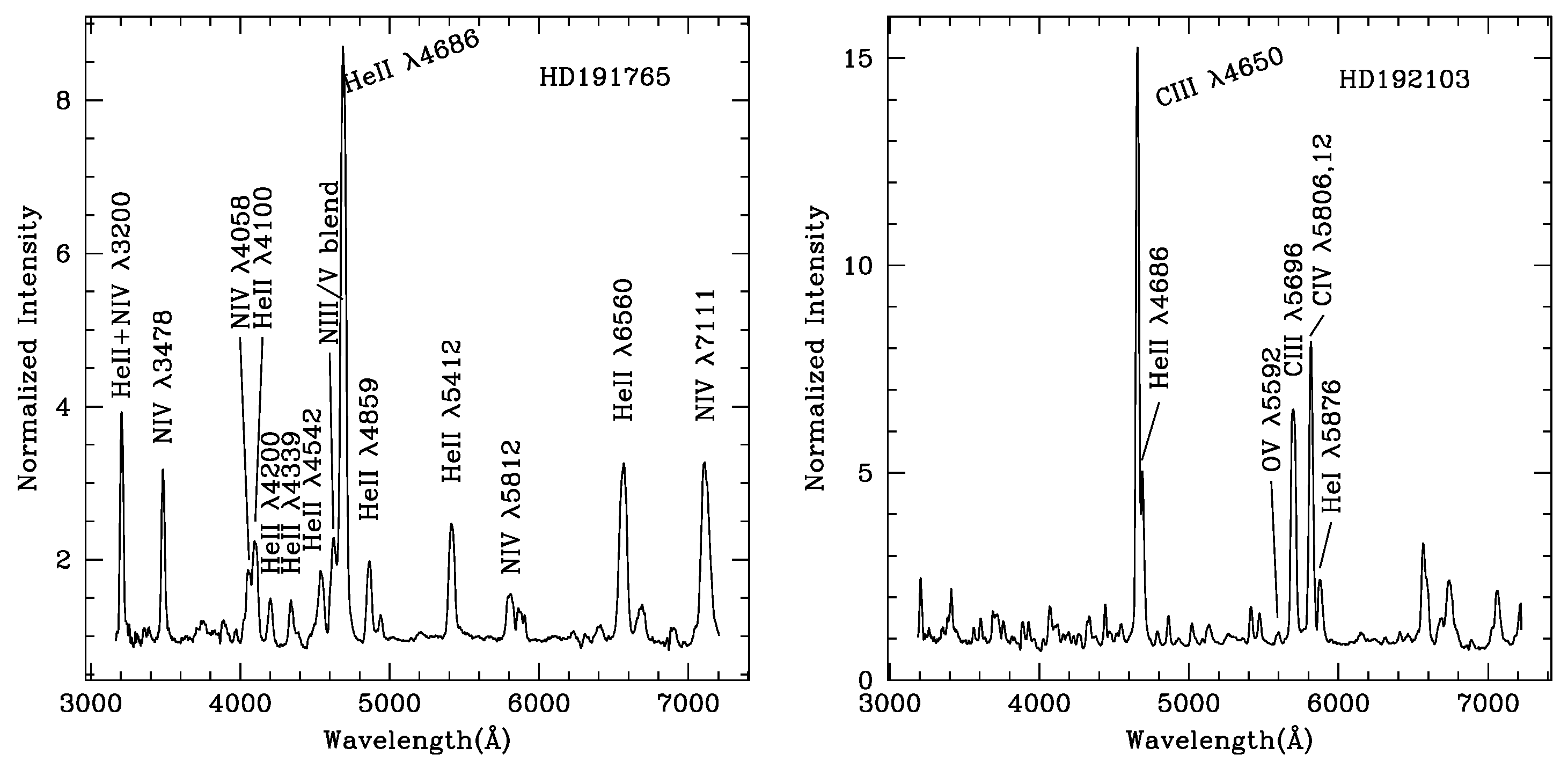
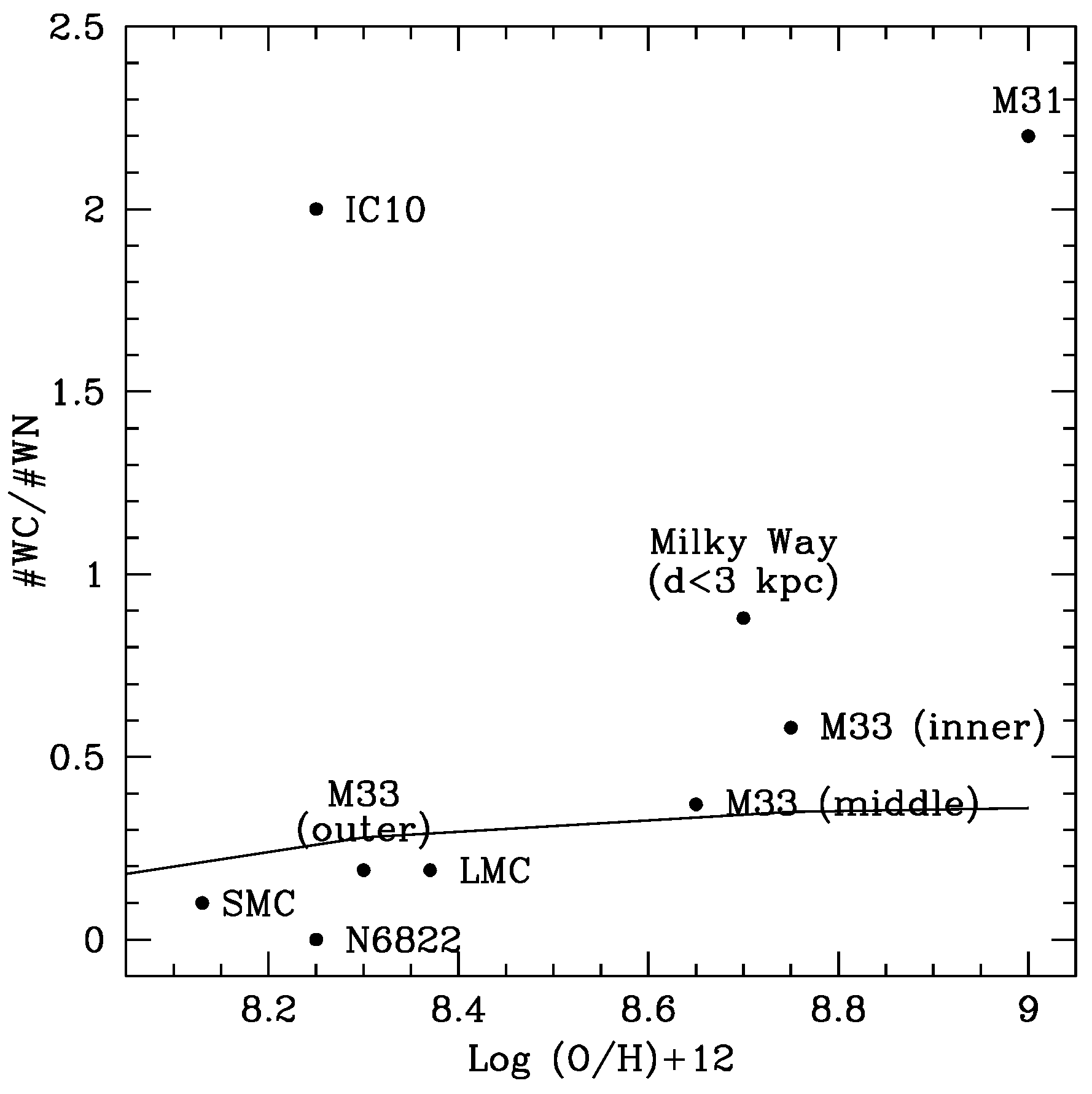
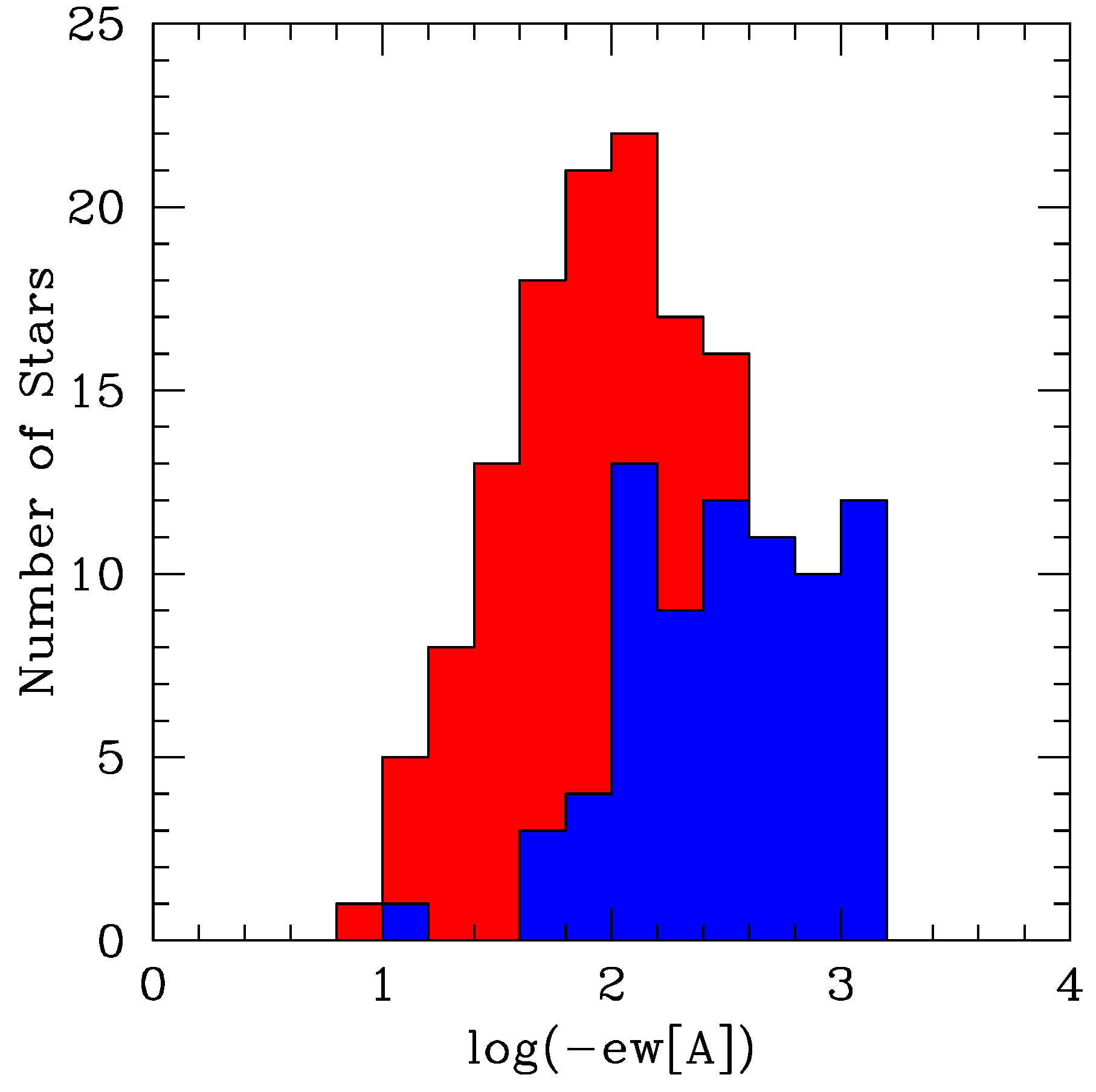
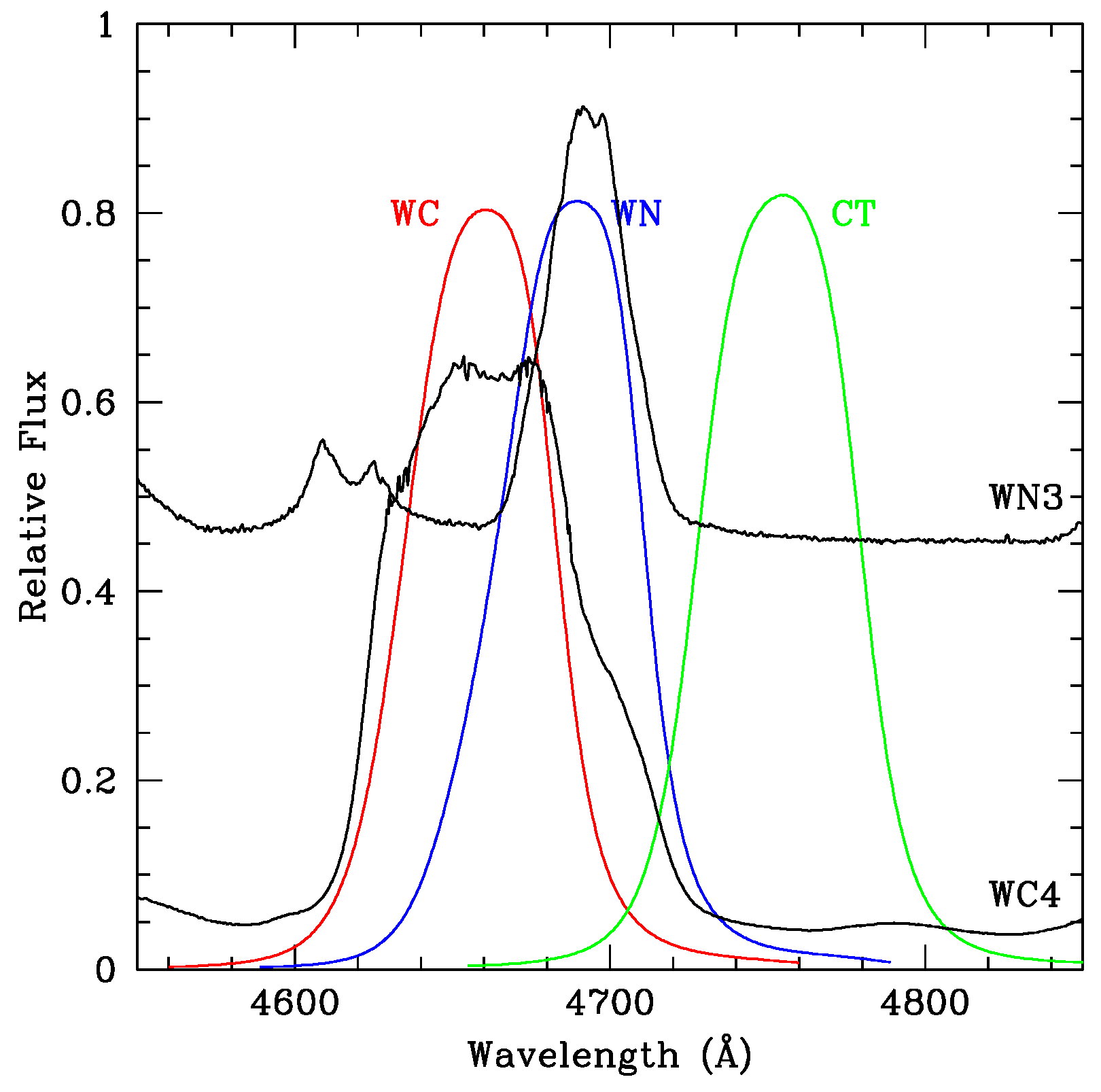
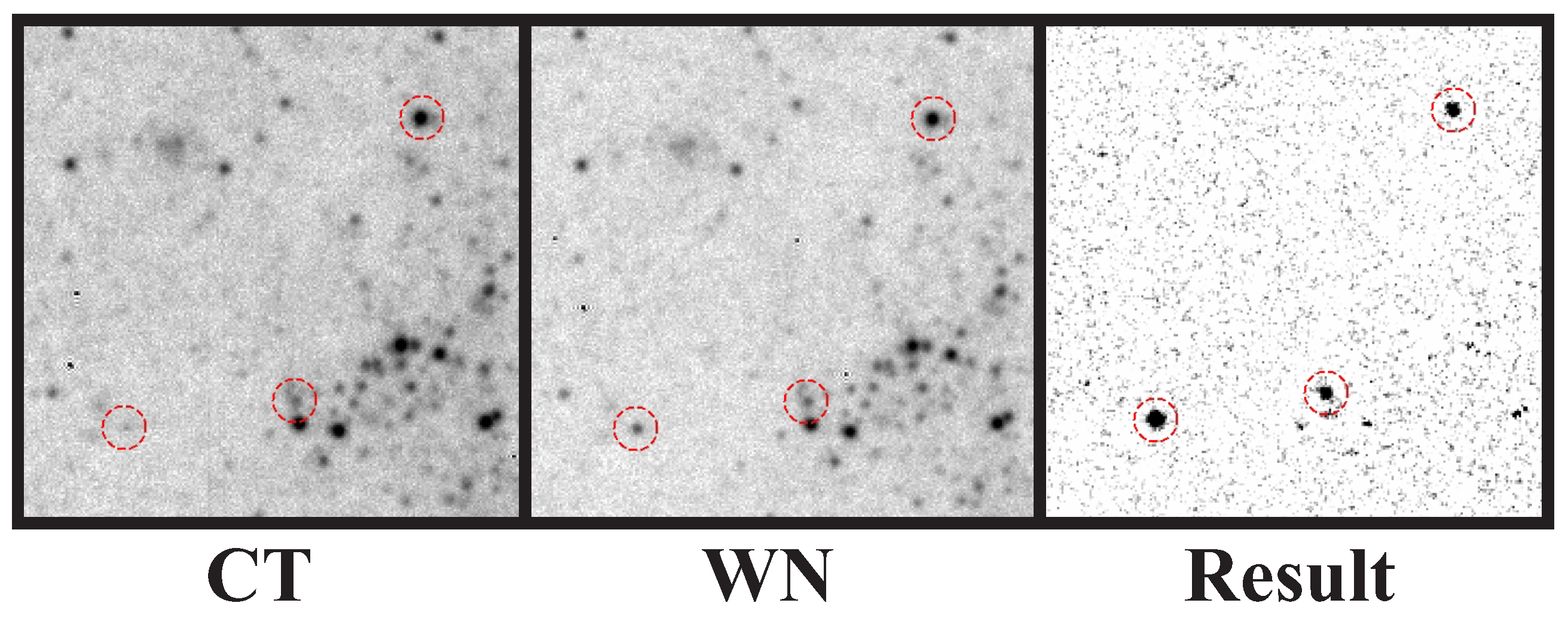
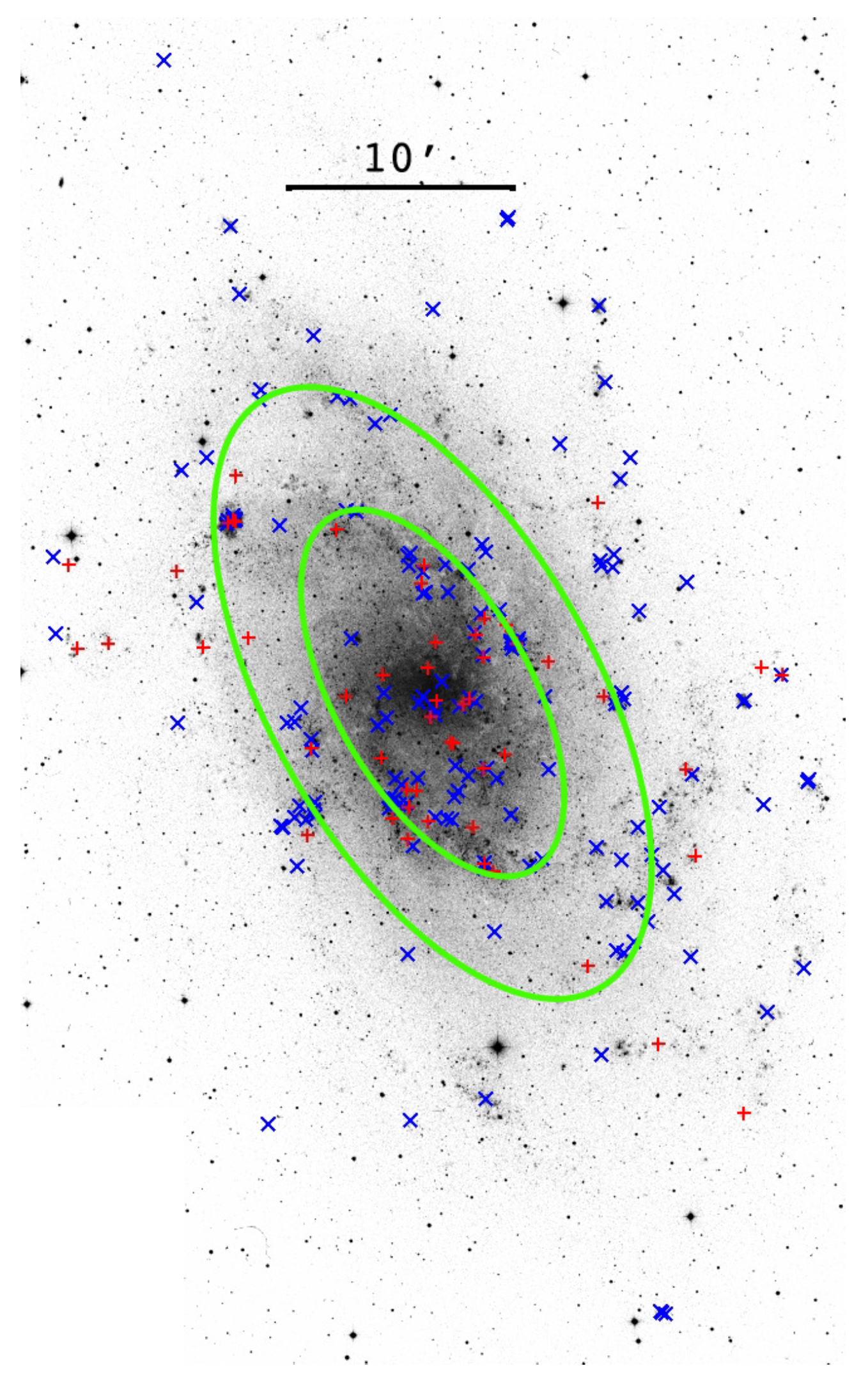

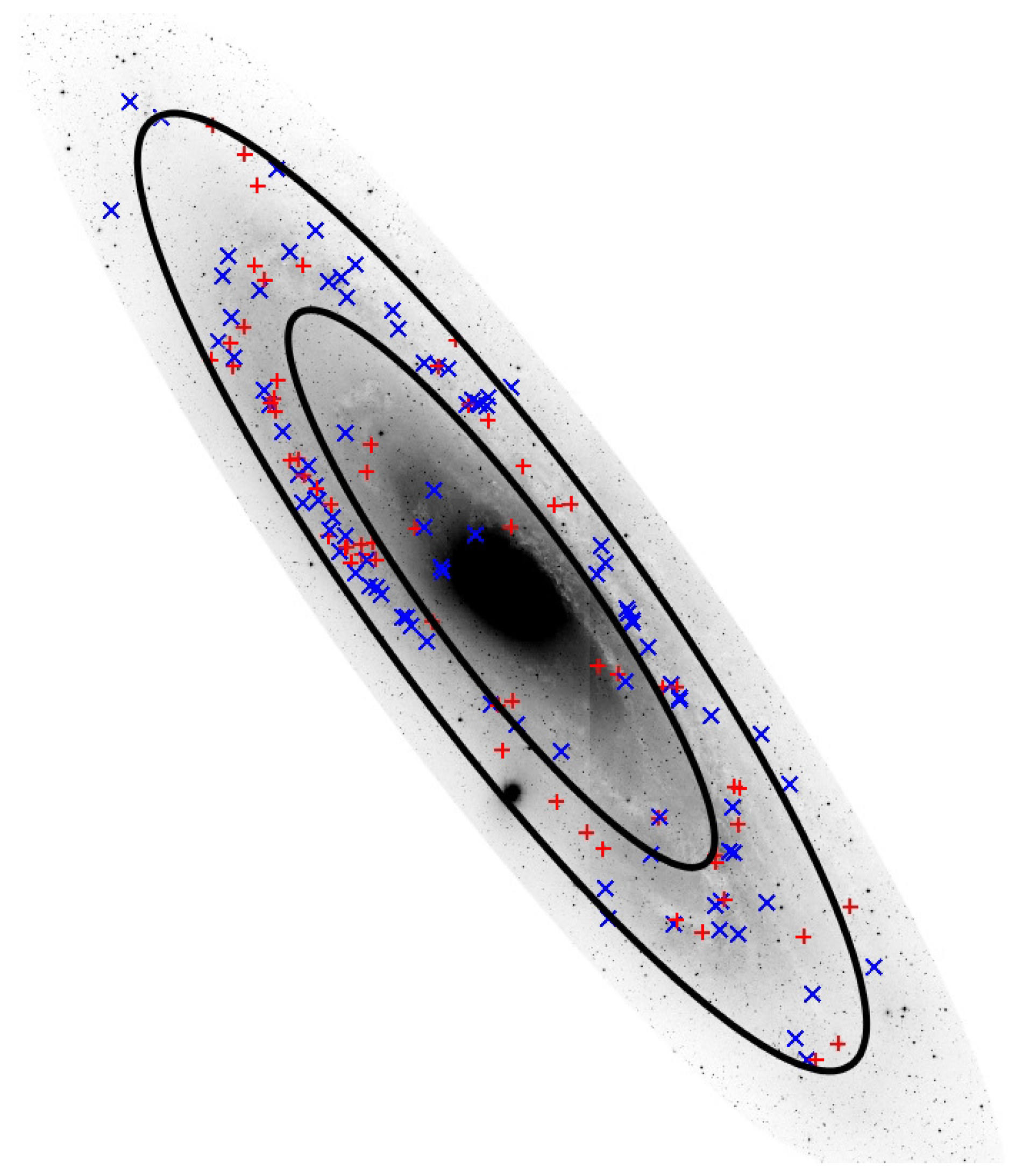
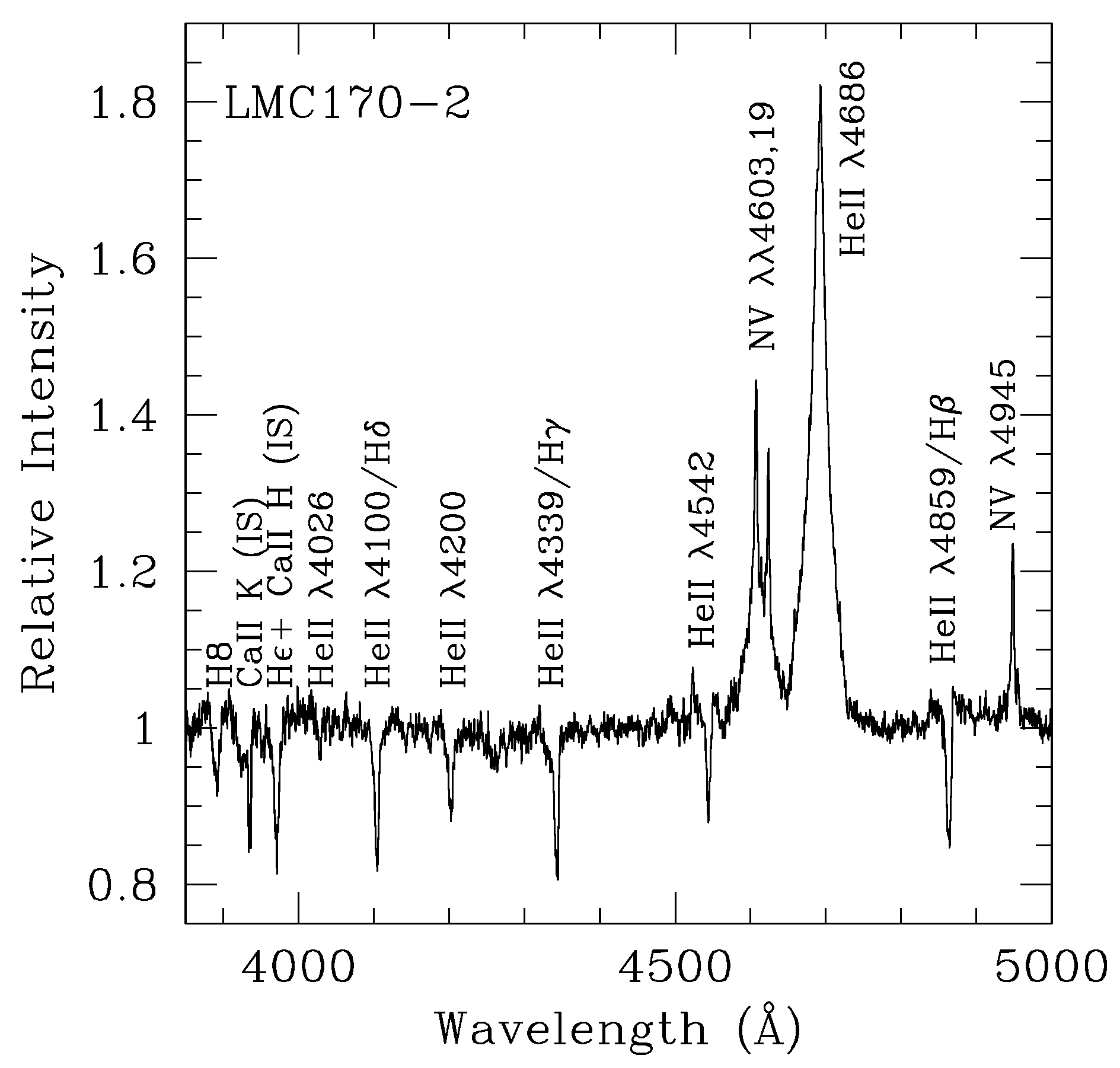
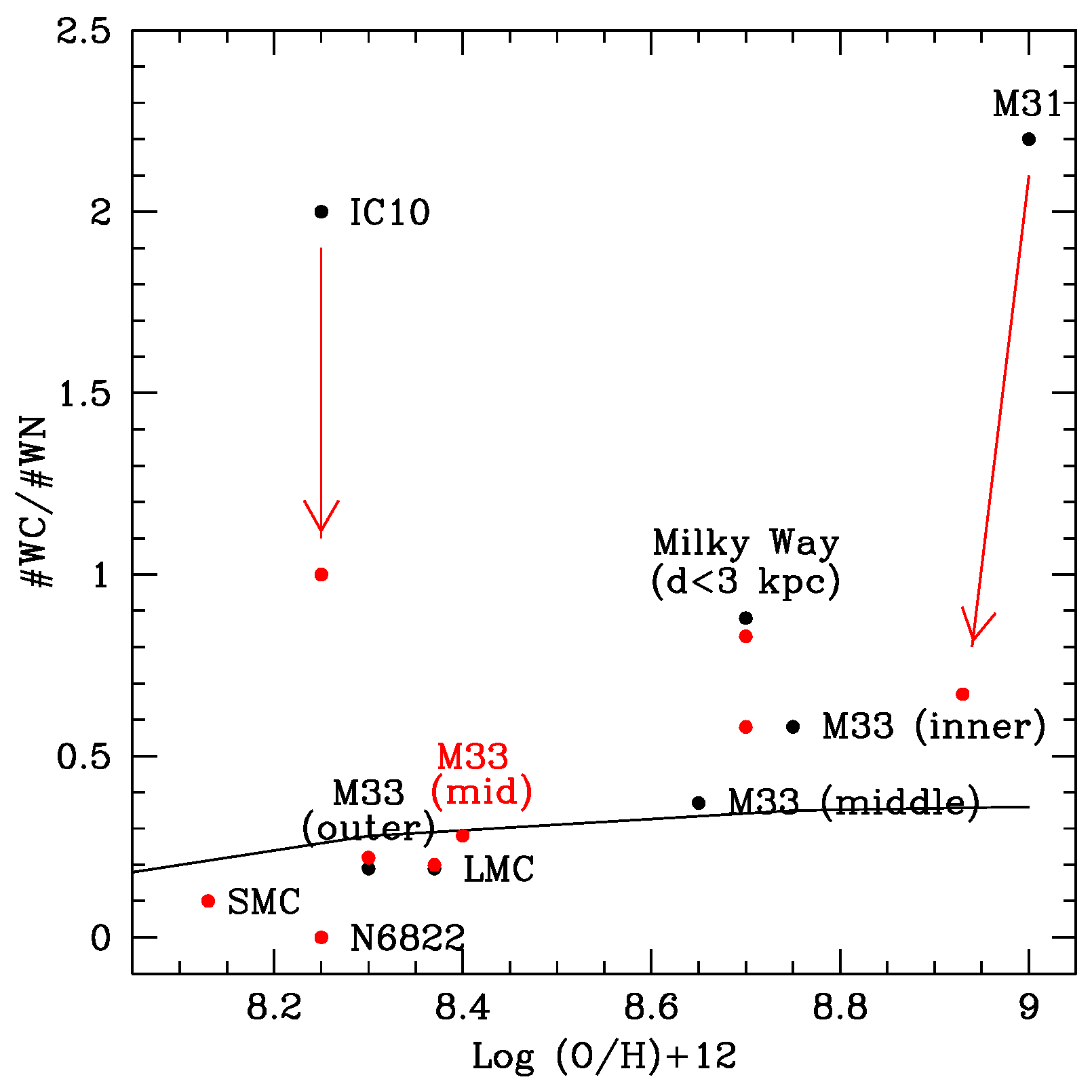
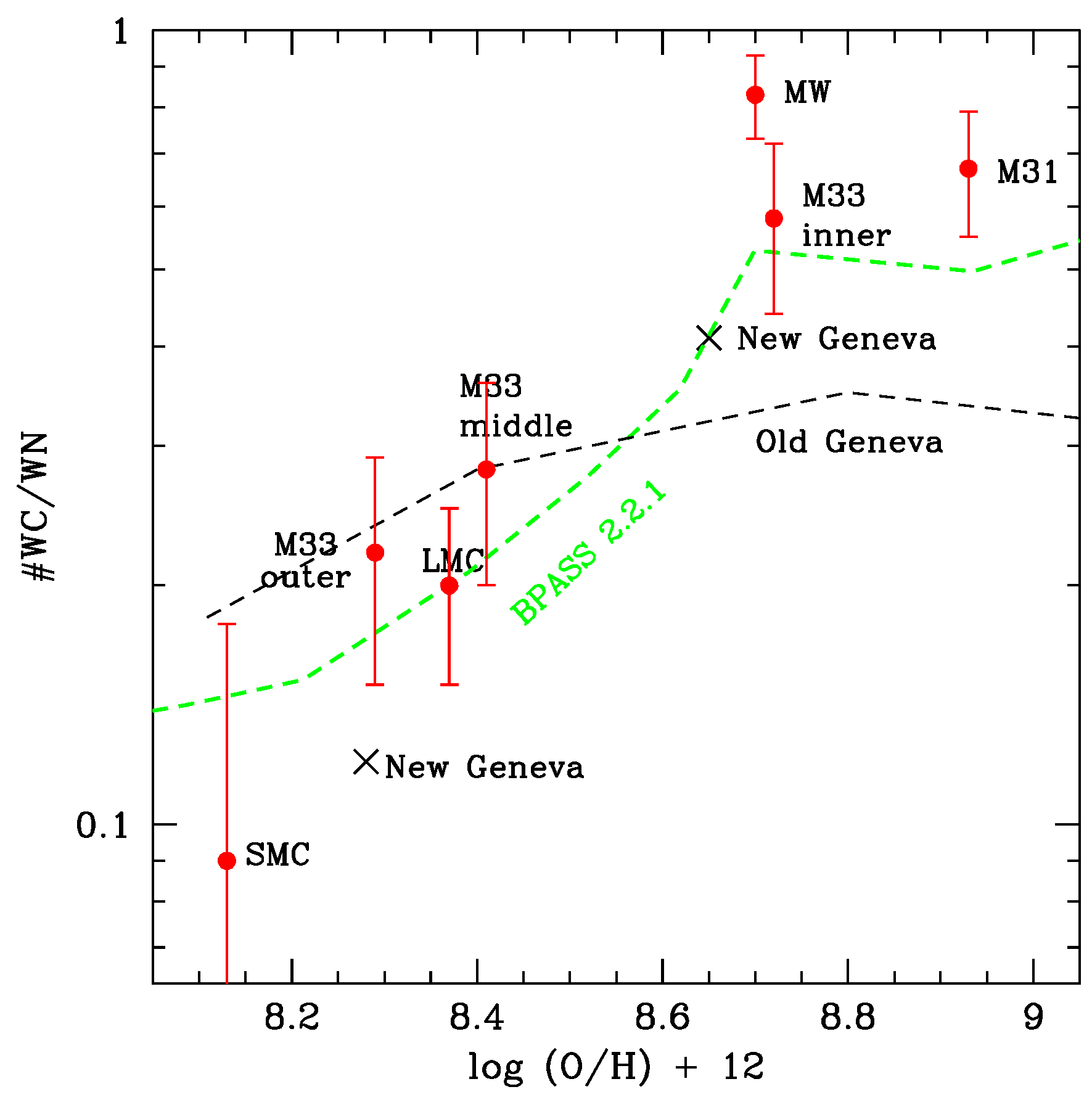
| Region | log(O/H) + 12 | # WCs | # WNs | WC/WN | |
|---|---|---|---|---|---|
| 0.16 | 8.72 | 26 | 45 | ||
| 0.38 | 8.41 | 15 | 54 | ||
| 0.69 | 8.29 | 12 | 54 |
| WN3/O3s | WN3 | O3V | |
|---|---|---|---|
| (K) | 100,000–105,000 | 80,000 | 48,000 |
| 5.6 | 5.7 | 5.6 | |
| −6.1–−5.7 | −4.5 | −5.9 | |
| He/H (by #) | 0.8–1.5 | 1.0–1.4 | 0.1 |
| N (by mass) | 5–10× solar | 5–10× solar | 0.5× solar |
| M | −2.5 | −4.5 | −5.5 |
| Region | log(O/H) + 12 | # WCs and WOs | # WNs | WC/WN |
|---|---|---|---|---|
| SMC | 8.13 | 1 | 11 | |
| M33 outer | 8.29 | 12 | 54 | |
| LMC | 8.37 | 28 | 124 | |
| M33 middle | 8.41 | 15 | 54 | |
| Milky Way | 8.70 | 46 | 53 | |
| M33 inner | 8.72 | 26 | 45 | |
| M31 | 8.93 | 62 | 92 |
© 2019 by the authors. Licensee MDPI, Basel, Switzerland. This article is an open access article distributed under the terms and conditions of the Creative Commons Attribution (CC BY) license (http://creativecommons.org/licenses/by/4.0/).
Share and Cite
Neugent, K.; Massey, P. The Wolf–Rayet Content of the Galaxies of the Local Group and Beyond. Galaxies 2019, 7, 74. https://doi.org/10.3390/galaxies7030074
Neugent K, Massey P. The Wolf–Rayet Content of the Galaxies of the Local Group and Beyond. Galaxies. 2019; 7(3):74. https://doi.org/10.3390/galaxies7030074
Chicago/Turabian StyleNeugent, Kathryn, and Philip Massey. 2019. "The Wolf–Rayet Content of the Galaxies of the Local Group and Beyond" Galaxies 7, no. 3: 74. https://doi.org/10.3390/galaxies7030074
APA StyleNeugent, K., & Massey, P. (2019). The Wolf–Rayet Content of the Galaxies of the Local Group and Beyond. Galaxies, 7(3), 74. https://doi.org/10.3390/galaxies7030074





